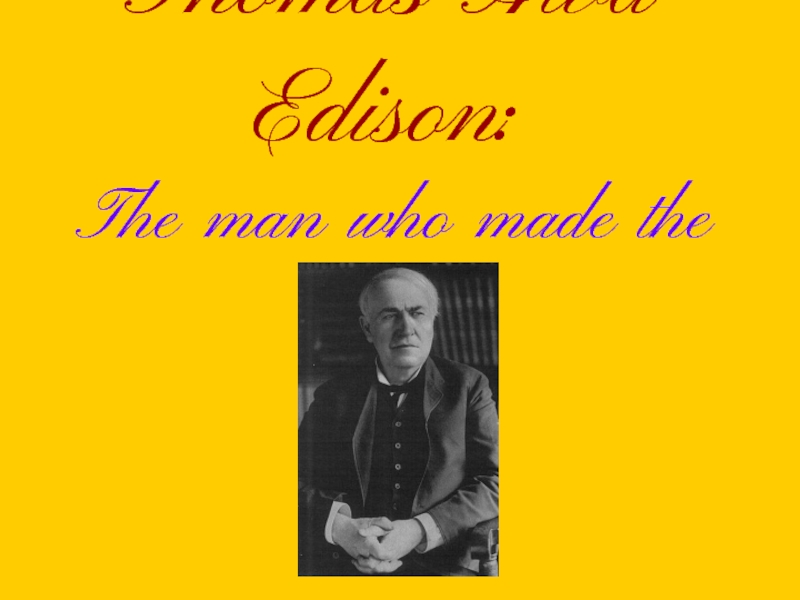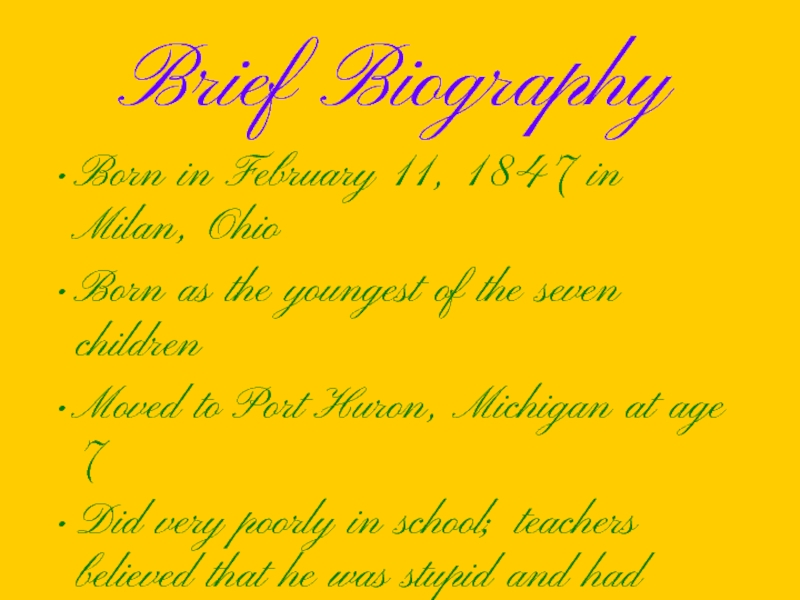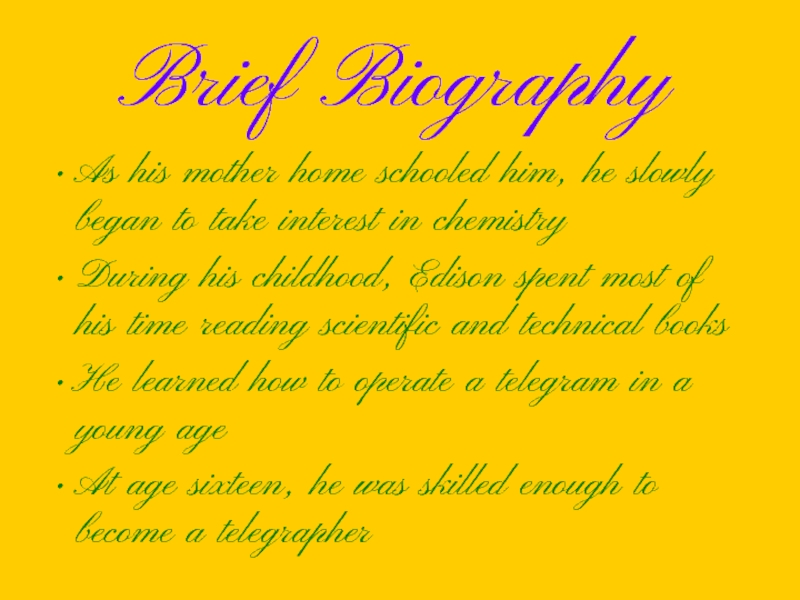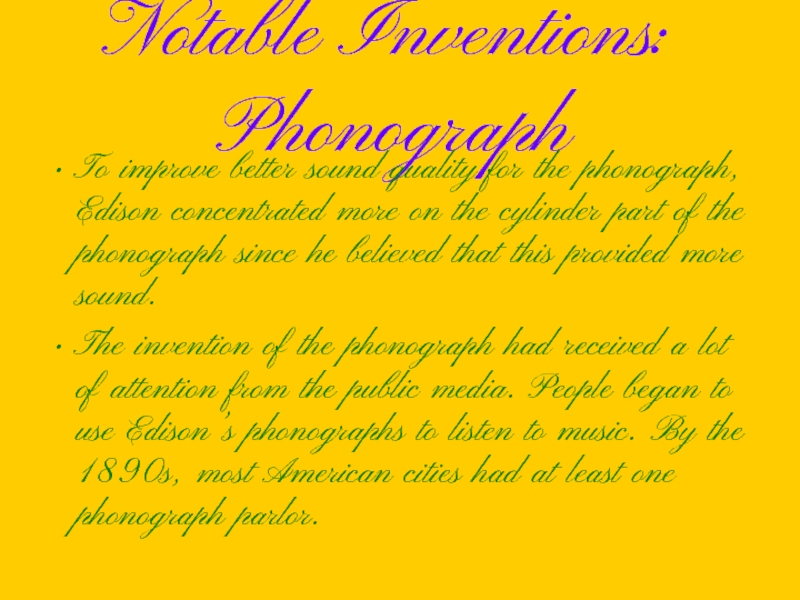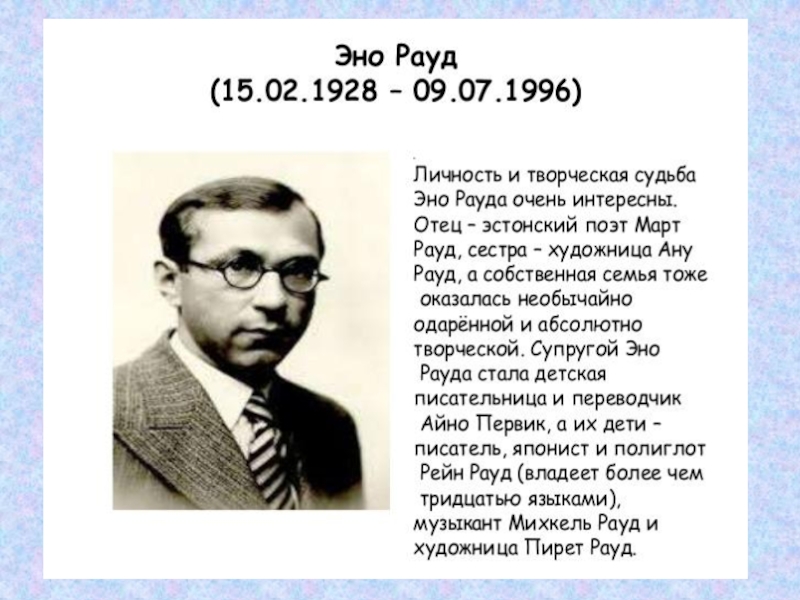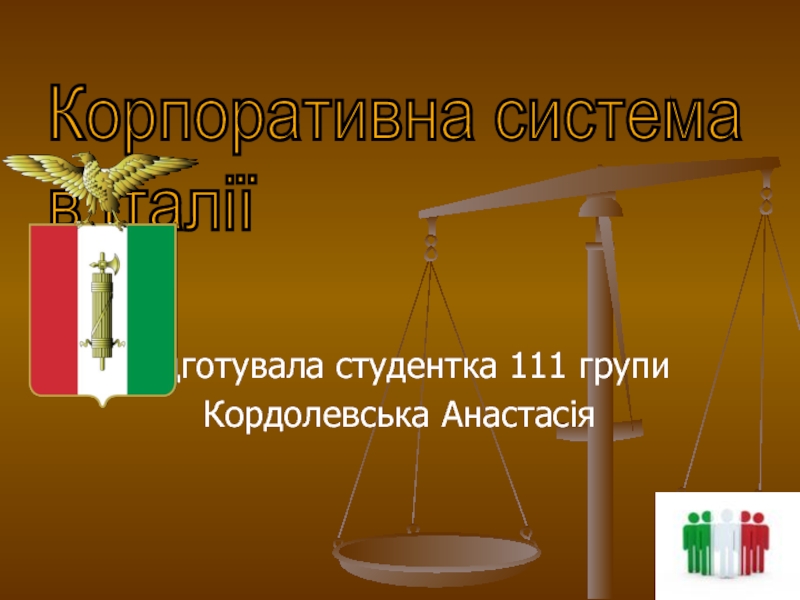- Главная
- Разное
- Дизайн
- Бизнес и предпринимательство
- Аналитика
- Образование
- Развлечения
- Красота и здоровье
- Финансы
- Государство
- Путешествия
- Спорт
- Недвижимость
- Армия
- Графика
- Культурология
- Еда и кулинария
- Лингвистика
- Английский язык
- Астрономия
- Алгебра
- Биология
- География
- Детские презентации
- Информатика
- История
- Литература
- Маркетинг
- Математика
- Медицина
- Менеджмент
- Музыка
- МХК
- Немецкий язык
- ОБЖ
- Обществознание
- Окружающий мир
- Педагогика
- Русский язык
- Технология
- Физика
- Философия
- Химия
- Шаблоны, картинки для презентаций
- Экология
- Экономика
- Юриспруденция
Thomas Alva Edison: The man who made the future презентация
Содержание
- 1. Thomas Alva Edison: The man who made the future
- 2. Brief Biography Born in February 11, 1847
- 3. Brief Biography As his mother home schooled
- 4. Notable Inventions The light bulb: (this is
- 5. Notable Inventions: Light Bulbs Contrary to popular
- 6. Notable Inventions: Light bulb Edison tried to
- 7. Notable Inventions The phonograph (this is the
- 8. Notable Inventions: Phonograph As the first inventor
- 9. Notable Inventions: Phonograph To improve better sound
- 10. Notable Invention The telegram (This is one of Edison’s version of the telegraph)
- 11. Notable Inventions: Telegraph Edison wasn’t necessarily the
- 12. Notable Inventions: Telegraph The quadruplex telegraph allowed
- 13. Additional Information on Edison Edison was a
Слайд 2Brief Biography
Born in February 11, 1847 in Milan, Ohio
Born as the
youngest of the seven children
Moved to Port Huron, Michigan at age 7
Did very poorly in school; teachers believed that he was stupid and had learning disability so his mother decided to home school him
Moved to Port Huron, Michigan at age 7
Did very poorly in school; teachers believed that he was stupid and had learning disability so his mother decided to home school him
Слайд 3Brief Biography
As his mother home schooled him, he slowly began to
take interest in chemistry
During his childhood, Edison spent most of his time reading scientific and technical books
He learned how to operate a telegram in a young age
At age sixteen, he was skilled enough to become a telegrapher
During his childhood, Edison spent most of his time reading scientific and technical books
He learned how to operate a telegram in a young age
At age sixteen, he was skilled enough to become a telegrapher
Слайд 4Notable Inventions
The light bulb: (this is the light bulb patent that
Edison had developed while inventing the bulb)
Слайд 5Notable Inventions: Light Bulbs
Contrary to popular belief, Edison didn’t really invent
the electric light bulb. However, he was credited for inventing incandescent light.
The first test of his light bulb took place in 1879.
Much of Edison’s earliest light bulbs had many flaws. They burned out shortly, were very expensive, and had higher electric current drawn.
These factors made the bulbs difficult to apply on a large scale commercially.
Below is one of Edison’s earliest light bulbs produced. This light bulb was the carbon-filament.
The first test of his light bulb took place in 1879.
Much of Edison’s earliest light bulbs had many flaws. They burned out shortly, were very expensive, and had higher electric current drawn.
These factors made the bulbs difficult to apply on a large scale commercially.
Below is one of Edison’s earliest light bulbs produced. This light bulb was the carbon-filament.
Слайд 6Notable Inventions: Light bulb
Edison tried to improve these factors. He finally
made his light bulbs high resistance lamps that are capable of withstanding very high vacuum. This helped produce better lighting and lasted longer than his earliest bulbs.
In 1878, Edison developed his own electric company with his financers. A year later, he publicly demonstrated how his light bulb worked. During this time he famously said “We will make electricity so cheap that only the rich will burn candles.”
In 1878, Edison developed his own electric company with his financers. A year later, he publicly demonstrated how his light bulb worked. During this time he famously said “We will make electricity so cheap that only the rich will burn candles.”
Слайд 7Notable Inventions
The phonograph (this is the patent of a phonograph that
Edison had developed while inventing the machine)
Слайд 8Notable Inventions: Phonograph
As the first inventor of the phonograph, Thomas Edison
had achieved the principle of recording and reproducing sound.
Before his achieved his fame for the light bulb, Edison initially focused on telegraphic devices like the phonograph.
The first phonograph that he invented was recorded in a tinfoil around a grooved cylinder.
This gave the phonograph a very poor sound quality.
Before his achieved his fame for the light bulb, Edison initially focused on telegraphic devices like the phonograph.
The first phonograph that he invented was recorded in a tinfoil around a grooved cylinder.
This gave the phonograph a very poor sound quality.
Слайд 9Notable Inventions: Phonograph
To improve better sound quality for the phonograph, Edison
concentrated more on the cylinder part of the phonograph since he believed that this provided more sound.
The invention of the phonograph had received a lot of attention from the public media. People began to use Edison’s phonographs to listen to music. By the 1890s, most American cities had at least one phonograph parlor.
The invention of the phonograph had received a lot of attention from the public media. People began to use Edison’s phonographs to listen to music. By the 1890s, most American cities had at least one phonograph parlor.
Слайд 11Notable Inventions: Telegraph
Edison wasn’t necessarily the first person who invented the
telegraph.
However, he was credited for the invention since his own version of the invention became popular.
Edison’s version of the telegraph was known as the full duplex two-way telegram or the quadruplex telegraph.
However, he was credited for the invention since his own version of the invention became popular.
Edison’s version of the telegraph was known as the full duplex two-way telegram or the quadruplex telegraph.
Слайд 12Notable Inventions: Telegraph
The quadruplex telegraph allowed users to send four separate
signals to be transmitted and received at the same time. The signals goes by two directions.
Edison’s version of the telegraph didn’t succeed commercially due to a major problem of unable to send two signals simultaneously in opposite directions on the same wire.
However, other inventors like Julius Wilhelm Gintl and J.B. Stearns were able to solve the problem.
Edison’s version of the telegraph didn’t succeed commercially due to a major problem of unable to send two signals simultaneously in opposite directions on the same wire.
However, other inventors like Julius Wilhelm Gintl and J.B. Stearns were able to solve the problem.
Слайд 13Additional Information on Edison
Edison was a freethinker. He viewed that beliefs
should be influenced by science and logic rather than emotion or tradition.
Edison was greatly influenced by the Age of Reason by Thomas Paine.
Edison’s moral views is based on nonviolence, and this moral view contribute to his inventions. “I am proud of the fact that I never invented weapons to kill.” “Nonviolence leads to the highest ethics, which is the goal of all evolution. Until we stop harming all other living beings, we are still savages.”
Edison was greatly influenced by the Age of Reason by Thomas Paine.
Edison’s moral views is based on nonviolence, and this moral view contribute to his inventions. “I am proud of the fact that I never invented weapons to kill.” “Nonviolence leads to the highest ethics, which is the goal of all evolution. Until we stop harming all other living beings, we are still savages.”
